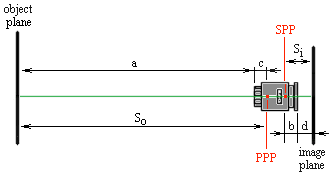Finding f with a Macro Lens
The Method
We start with equations (5) and (6) as derived on the leading page.
1 1 1
----- + ----- = - (5)
a + b c + d f
c + d
M = ----- (6)
a + b
Then we express c + d from (6), substitute into (5), and solve for f:
c + d = M (a + b)
1 1 1
- = ----- + ----- <=>
f a + b c + d
1 1 1
- = ----- + --------- <=>
f a + b M (a + b)
1 M + 1
- = --------- =>
f M (a + b)
f (M + 1) = M (a + b) (7)
The unknowns here are M, a, and b. M is easy — we use a macro lens, and read it right off the lens barrel.
To find out a, we proceed as follows:
- Mount the lens on a camera body.
- Turn the lens focusing ring to a freely chosen magnification ratio M.
- Focus on an object by moving the lens-camera combo back and forth.
- Measure the distance a between the object and the front-most point of the lens.
For b we perform these further steps:
- Find a dark distant object in front of a bright background (for example a distant tree in front of a sunrise or a sunset).
- Without refocusing the lens, take it off the camera, and point its rear element towards the object.
- Place a white piece of paper behind the front element of the lens. Use the paper as a screen to project an image with the lens.
- Move the paper back and forth until the image of the distant tree is in focus.
- Measure the distance d between the front-most point of the lens filter thread and the paper.
Figure 1 illustrates.

Figure 1.
Now we see how to calculate b from d. We start again with equation (5), but because the lens is used backwards, and because of the equation’s symmetry, b and c swap their positions. So (5) becomes:
1 1 1
----- + ----- = - (8)
a + c b + d f
Now comes the approximation — we assume that the distance to the object (the tree) is equal to infinity. Equation (8) then simplifies to:
1 1 1
-------- + ----- = - <=>
infinity b + d f
1 1
----- = - <=>
b + d f
f = b + d <=>
b = f - d (9)
Now we substitute (9) into (7), and solve for f:
f (M + 1) = M (a + f - d) <=>
fM + f = fM + M (a - d) <=>
f = M (a - d).
Method Evaluation
The two main merits of this method are:
- Simplicity, both experimental and mathematical.
- High tolerance to measurement errors. We measure the quantities a and d, and their dependance to f is linear. Second, we are free to choose M, and for smaller values, the effect of any measurement errors decreases.
At the same time, three main drawbacks should be pointed out:
- Because the method assumes that the distant object lies at infinity, the result is only approximate. The ill-effects of this approximation are very small, however. For example, for a 100 mm lens and an object located 20 meters away instead of at infinity, the maximum error in f is 0.5 millimeters (for M = 1:1, smaller for smaller values of M).
- The method is directly applicable only for lenses that have the magnification ratio marked on the barrel. It can be applied to any lens, but then M must be calculated in a separate experiment.
- The method finds the focal length only for the chosen M. In general this is no limitation, as most lenses retain a constant f as they are refocused. For those that do change f, the method can be applied a number of times to get an idea of how f changes. The method fails for one important case, however, when the lens is focused at infinity (M = 0). This is so because M is present in the final expression for f.